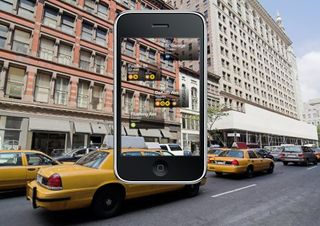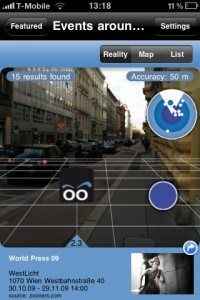Augmented Reality: What It Is, How We Use It, & What It Will Become

Augmented reality (also known as AR) sounds like a reference to life on a distant planet, or some sort of Fringe device that slips your mind into a fifth dimension. In fact, this term is used to describe an emerging type of technology. Put simply, AR can help you learn about the people and places around you in real time, and is found primarily in smart phone applications today. But location-based services are just the tip of the iceberg.
At its core, augmented reality is all about changing our view of the world by merging our environmental surroundings with digital data and media. But for this technology to evolve, there must be rules regarding what can truly be defined as augmenting reality, and what can’t. “The key is that the virtual content be registered (or aligned) with the right parts of the physical world,” explained Blair MacIntyre, PhD, associate professor at Georgia Tech’s College of Computing and director of the school’s Augmented Environments Lab. “Also, the application must be interactive.”
Beyond these basic principles, how is this technology being used today? And what can we expect to see in the near future?
Augmented Reality On Your Phone
There are about a dozen Augmented Reality applications available across various smart phone operating system platforms, including Android and iPhone OS. For example, Acrossair’s New York Nearest Subway iPhone app ($1.99; www.acrossair.com; iTunes) overlays the nearest subway stations on a picture of your surroundings by leveraging your handset’s camera. When we fired up the app while standing outside our office, subway entrances in our immediate area littered the screen. Turn left, right, or in a circle, and the application uses the phone’s compass to display the subway stations in other directions.

During our tests, we found Acrossair to be accurate enough to get us close to subways, but it didn’t point to every entrance available for a station. Applications such as this point to what Dr. MacIntyre refers to as “sort of approximate” locations in the world, which are sometimes far away from the actual site. These apps could be thought of as a precursor to what AR has the potential to become.

Another smart phone application, Layar Reality Browser 2.0 for Android (Free; www.layar.eu), layers information on top of the phone’s camera interface to show you digital happenings in your vicinity. The Tweeps Around layer, for example, reveals recent status updates from Twitter users who are tweeting from a GPS-enabled phone. Each update floats around the screen, and as you turn the phone, more will appear. The Wikipedia layer shows you data about local points of interest, such as landmark buildings. You can click each POI by hovering over the icon, which launches a Wikipedia page with more information. Yet another layer called FlickAR shows geotagged pictures taken near you, along with those recently uploaded to Flickr. There are layers for topics ranging from nearby eateries to architecture guides, and even the nearest Mazda car dealership.
Stay in the know with Laptop Mag
Get our in-depth reviews, helpful tips, great deals, and the biggest news stories delivered to your inbox.
Although Layar lets you search through your results and expand the range of its view, most of the layers are more amusing than useful, and they’re not always accurate. For example, Tweeps Around didn’t pick up tweets from coworkers in our immediate vicinity. Solving the accuracy problem could make all the difference for the success of these apps, according to some experts.
“Think about what Acrossair’s apps would be like if they could show solid-feeling graphics—if the restaurant information appeared to be painted on the front of the building. Or if the directions appeared to be painted on the ground, and not hovering and bobbing around,” Dr. MacIntyre explained.
Once AR applications are able to paint a picture exactly where we need them, they become more useful and less distracting. Take, for example, a potential application that could show us the movie times of a given theater whenever we hover our cell phone camera over the building. “In the mobile environment, we want to be productive,” said Dan Shey, practice director of mobile services with ABI Research. “If there’s the ability to use your phone to be as productive as possible, AR applications will sell.”
Business Uses of Augmented Reality
AR isn’t just about finding subway entrances or the closest place to scarf a burger. There’s a lot of potential for the technology within infrastructure and healthcare fields that have yet to be fully explored. Dr. MacIntyre envisions scenarios where doctors can superimpose information onto a patient’s body so that surgeons can see both the body and digital information at once. “Think about one of those small scopes used in surgery, but where the video is augmented with ultrasound or CT scan information, or with surgical preplanning information,” MacIntyre said.
If you break your leg, for example, imagine if your doctor donned a headset to see exactly where it was broken. She could then explain the damage and next steps while you see the results for yourself on a larger screen.
“The good thing about the medical domain is that it doesn’t suffer from the need to work everywhere, as the mobile applications do,” said MacIntyre. “It would be a small investment, relative to the cost of medical equipment. You could make AR work only in a doctor’s office.”
Dr. MacIntyre also sees other uses in such fields as architecture, where AR could be used to show what building locations will look like should changes be made to the land, or even to the building itself. These changes could be made in real time. Likewise, construction crews could safely use AR to visualize submerged pipes, wires, and more before digging.
Smarter Shopping, More Immersive Gaming with Augmented Reality
ABI’s Shey imagines a world in which consumers download applications from stores to help them make purchasing decisions. For example, in a hypothetical Ikea application, when you point your phone’s camera at an empty room, you could begin to decorate it with furniture available from Ikea’s catalog. The app could then let you purchase those goods.
AR could even help retailers boost brand awareness. Shey sees cloud-based AR as a way for brands to establish themselves, assuming existing cell phone networks can handle the added data. And despite that possible hurdle, he argues that most of today’s phones don’t have the processing power needed to perform advanced AR tasks. “If you want to add contextual information to an application you’re using, when it comes to augmented reality, you’re talking about a lot of processing power,” he said. “There [also] has to be some processing that happens in the cloud to provide the value to the application.” However, 1-GHz mobile processors from Qualcomm, Samsung, and others are starting to hit higher-end handsets.
In the immediate future, experts agree that after the first wave of AR mobile apps, the gaming industry will be the first to harness the power of this technology. That’s because AR works best in controlled environments, meaning it would be localized to your living room and used strictly for gaming. In fact, gaming manufacturers have already dangled their toes in the water. A title called The Eye of Judgement, released in 2007 for PlayStation 3, used the console’s eye camera technology to make playing cards come to life. When the cards were placed under the camera’s lens, it created 3D AR creatures that appeared on your TV.
For now, the future of AR remains somewhat murky. Dr. MacIntyre says many questions have yet to be answered. “When will nongaming apps start becoming useful and widespread? Will mobile phone-based AR be enough, or will it only take off when head-worn displays become practical?” The answers seem to rely on our infrastructure. Until data networks for cloud-based AR improves—it’s possible that 4G cellular networks are a step in the right direction—and until developers can create more precise models, mobile AR will remain little more than just a promise of a richer, more digitally connected world.
